| |
|
|
.... thus shall ye deal with them;
ye shall destroy their altars, and break down their
images, and cut down their groves, and burn their graven
images with fire.
|
|
Deuteronomy 7:5
|
In this section we look at how the Christian Church has influenced
classical culture, European culture and world culture.
Whenever books are burned men also in the end are burned.
Heinrich Heine (1797-1856), Almansor
All religious traditions had been tolerated under the Roman
Empire, although Christians suffered to some extent because
of their sedition. They stated openly that they desired the
destruction of the Empire, encouraged soldiers to desert, aparantly
assassinated oponents, vandalised sacred monuments and statues,
and tried to destroy the city of Rome by means of arson.
|
Christians tried repeatedly to destroy
the city of Rome
|
|
|
As soon as the Empire became Christian, this toleration ceased.
The only writings to be permitted were those supported by the
line currently regarded as orthodox. By 326 Constantine had
authorised the confiscation and destruction of anything that
challenged orthodoxy (i.e. the orthodoxy established the previous
year). This included non-Christian places of worship as well
as works by pagan authors and by all other Christian factions.
Soon afterwards Constantine's mother Helena and Macarius, the
Bishop of Jerusalem, were supervising the destruction of a temple
in Jerusalem dedicated to Aphrodite, and building a Christian
basilica on the site. This basilica, now the Church of the Holy
Sepulchre, was imagined to be the very burial site of Jesus
and to encompass the place of crucifixion. Evidence was conveniently
discovered in the form of a tomb and miracle working splinters
of the True Cross. Countless thousands of architectural treasures
from classical times were soon being vandalised in the same
way and turned into Churches.
|
Christians were keen to emulate selected
Jewish practices. Josiah enforced the exclusive worship
of Yahweh (2 Kings 23). According to the biblical account,
he destroyed pagan objects related to the worship of Baal
or Asherah. He had pagan priests executed and had the
bones of the dead priests of Bethel exhumed and burned
on their own altars. According to 2 Chronicles, Josiah
destroyed altars and images of pagan deities in cities
of neighbouring tribes of Manasseh, Ephraim, "and
Simeon, as far as Naphtali" (2 Chronicles 34:6-7)
Below, Josiah is destorying pagan religious items and
a pagan altar, just as Christian missionaries were to
destroy pagan religious icons and altars for centuries
to come.
|
|
|
Christian power grew, and Christians were soon denying freedom
of religion to everyone except followers of the Christian faction
currently in favour. In the year that the Emperor Constantine
inaugurated his new capital at Byzantium, AD 330, he prohibited
the performance of rites of other faiths there. In 333, Christian
censorship, pillaging, dispossession and judicial killing started
in earnest. Not only were works of Arius, but also people who
owned such works, to be consigned to the flames. Gold and treasure
were removed from Eastern temples. Under Constantine's Christian
sons, the trend developed further. More temples were destroyed,
and sacrifices were forbidden. Marriages between Christians
and Jews were declared illegal, and the crime was punishable
by death. Constantius II passed laws against pagans in 341,
and in the following years further laws were passed to the effect
that all superstition (i.e. other religions) be completely eradicated.
Soon, anyone performing traditional sacrifices would be liable
to the death penalty. In town and country, temples were demolished
or seized and turned into churches. Bands of violent monks were
deployed to ensure the domination of the orthodox line. They
were sometimes commanded by bishops. As a modern, devout Christian,
historian says:
The monks were often formed, or formed themselves, into black-robed
squads for the execution of the Church's business, first to
smash up pagan temples, later to rampage through the streets
in time of doctrinal controversy. Monasticism attracted misfits,
bankrupts, criminals, homosexuals, fugitives as well as the
pious; it was also a career for raw peasant youths who could
be drilled into well-disciplined monkish regiments to be deployed
as an unscrupulous bishop might think fit1.
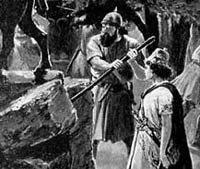  Other
recruits included draft-dodgers, runaway slaves and lunatics.
Cultured pagans were appalled by their vandalism. The pattern
continued until Julian was declared emperor in 360. Julian,
known as Julian the Apostate, rejected Christianity in favour
of traditional religions. He reopened and repaired pagan temples
and restored the tradition of universal toleration. He restored
Jerusalem to the Jews, revoked anti-Semitic legislation and
authorised the rebuilding of the Jewish Temple. Other
recruits included draft-dodgers, runaway slaves and lunatics.
Cultured pagans were appalled by their vandalism. The pattern
continued until Julian was declared emperor in 360. Julian,
known as Julian the Apostate, rejected Christianity in favour
of traditional religions. He reopened and repaired pagan temples
and restored the tradition of universal toleration. He restored
Jerusalem to the Jews, revoked anti-Semitic legislation and
authorised the rebuilding of the Jewish Temple.
His toleration was not appreciated by Christians, who insulted
and destroyed new temples in Syria and Asia Minor. The rebuilding
of the Jewish Temple in Jerusalem was set back by a mysterious
fire, possibly one of the many instances of arson carried out
by Christians. There is more than a suspicion that Julian's
untimely death was attributable to disloyal Christians. Certainly,
many Christians did not trouble to disguise their glee at his
demise, and attributed it to Christian agency.
  After
Julian, the Empire returned to Christian government. Christian
rulers resumed the destruction of temples and cancelled the
rebuilding of the Jewish Temple. By 380 Christianity was the
only recognised religion in the Empire. As part of its campaign
books were burned, works of art destroyed, families dispossessed,
and temples desecrated. Christians delighted in their victory,
and seized opportunities for destruction of everything others
held holy. After
Julian, the Empire returned to Christian government. Christian
rulers resumed the destruction of temples and cancelled the
rebuilding of the Jewish Temple. By 380 Christianity was the
only recognised religion in the Empire. As part of its campaign
books were burned, works of art destroyed, families dispossessed,
and temples desecrated. Christians delighted in their victory,
and seized opportunities for destruction of everything others
held holy.
The Christian Emperor Theodosius I closed pagan temples in
Rome at the end of the fourth century, in line with the views
of St Ambrose. Under his influence, the Emperor adopted an official
policy of Christian uniformity. Christian mobs were free to
attack and destroy synagogues and temples with impunity. Spies
were appointed to expose those who were not sufficiently sympathetic
to the Christian cause. It was Ambrose who dissuaded the Emperor
from paying compensation for the destruction of a synagogue
in 388.
  For
a while Christians stuck to their home churches, often the private
basilicas (audience chambers) of rich converts. As Christianity
adopted ever more pagan practices and trappings, old pagan temples
were recognized as ideal locations for their meetings and ceremonies.
Pagan temples were then appropriated for use as churches. This
happened to countless thousands of temples throughout the Roman
Empire. In Rome itself numerous pagan temples were converted
into churches, as confirmed by archeological investigations.
On the Roman Forum alone, the Curia Julia or Roman Senate
building became the church of Sant'Adriano in Foro, the Temple
of Antoninus and Faustina became the church of San Lorenzo in
Miranda, and the Temple of Romulus became the church of Santi
Cosma e Damiano. St. Peter's Basilica, the church of the Vatican,
was built on top of a large pagan necropolis on the Vatican
Hill. Pagan gods and their temples are sometimes remembered
in the names of Roman churches, for example the church of Santa
Maria sopra Minerva (literally Saint Mary above Minerva). The
Basilica of St. Mary of the Angels and the Martyrs (Santa Maria
degli Angeli e dei Martiri) is a basilica church, built inside
the frigidarium of the Baths of Diocletian in the Piazza della
Repubblica in Rome. For
a while Christians stuck to their home churches, often the private
basilicas (audience chambers) of rich converts. As Christianity
adopted ever more pagan practices and trappings, old pagan temples
were recognized as ideal locations for their meetings and ceremonies.
Pagan temples were then appropriated for use as churches. This
happened to countless thousands of temples throughout the Roman
Empire. In Rome itself numerous pagan temples were converted
into churches, as confirmed by archeological investigations.
On the Roman Forum alone, the Curia Julia or Roman Senate
building became the church of Sant'Adriano in Foro, the Temple
of Antoninus and Faustina became the church of San Lorenzo in
Miranda, and the Temple of Romulus became the church of Santi
Cosma e Damiano. St. Peter's Basilica, the church of the Vatican,
was built on top of a large pagan necropolis on the Vatican
Hill. Pagan gods and their temples are sometimes remembered
in the names of Roman churches, for example the church of Santa
Maria sopra Minerva (literally Saint Mary above Minerva). The
Basilica of St. Mary of the Angels and the Martyrs (Santa Maria
degli Angeli e dei Martiri) is a basilica church, built inside
the frigidarium of the Baths of Diocletian in the Piazza della
Repubblica in Rome.
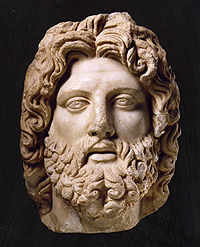  Officially
sanctioned Christian Vandalism became ever more commonplace.
At Alexandria in 389, Bishop Theophilus of Alexandria personally
directed the destruction of the temple to the god Serapis, reputedly
the largest place of worship in the known world. The statue
of the god was chopped up and burned, its head being carried
through the town for public ridicule. The temple precinct, or
Serapeum, also housed a scientific research institute (a "Museum"
named after the nine Muses) and the famous Library of Alexandria
- two of the greatest academic buildings in human history. Both
buildings were loathed by Christians, who hated scientific research
and secular knowledge as much as they hated other people's places
of worship. Both Museum and Library were destroyed around this
time, probably in the same violent incident in which the bishop
destroyed the temple. The destruction of the Serapeum by Patriarch
Theophilus was a critical event in the history of persecution
of ancient paganism. A later bishop of the same city, Saint
Cyril was responsible for the murder of the pholosopher Hypatia. Officially
sanctioned Christian Vandalism became ever more commonplace.
At Alexandria in 389, Bishop Theophilus of Alexandria personally
directed the destruction of the temple to the god Serapis, reputedly
the largest place of worship in the known world. The statue
of the god was chopped up and burned, its head being carried
through the town for public ridicule. The temple precinct, or
Serapeum, also housed a scientific research institute (a "Museum"
named after the nine Muses) and the famous Library of Alexandria
- two of the greatest academic buildings in human history. Both
buildings were loathed by Christians, who hated scientific research
and secular knowledge as much as they hated other people's places
of worship. Both Museum and Library were destroyed around this
time, probably in the same violent incident in which the bishop
destroyed the temple. The destruction of the Serapeum by Patriarch
Theophilus was a critical event in the history of persecution
of ancient paganism. A later bishop of the same city, Saint
Cyril was responsible for the murder of the pholosopher Hypatia.
|
Christian cross carved into Egyptian
hieroglyphics at Temple of Isis at Philae, in southern
Egypt
We have no idea how many other images were completely
destroyed by Christians.
|
|
|
The famous Temple of Apollo at Patara was destroyed, possibly
by St Nicholas, a bishop now better known as Santa Claus. Certainly
he, like many other bishops, was a keen destroyer of other people's
holy places in the area. Throughout Egypt bands of monks commissioned
by bishops were given military protection so that they could
despoil the shrines of other faiths in safety. Notre-Dame de
la Daurade is a basilica in Toulouse, France. It was established
in 410 when Emperor Honorius allowed the conversion of Pagan
temples to Christianity. The original building here was a temple
dedicated to Apollo.
In the fifth century, the cult of Alexander, which had survived
in the desert oasis at Siwa, was suppressed. By the sixth century
the Christian Emperor Justinian closed the last temples in Egypt
dedicated to the cults of Isis and Ammon. Centuries later Christians
were still seizing wooden icons from devotees of other religions
in Egypt. They were sent to Constantinople to be burned in the
hippodrome. The famous shrine of the goddess Ma in Comana in
Cappadocia was converted into a church. The Parthenon in Athens
was also converted, and so was the Temple of Rhea at Byzantium.
The Temple of Athene at Syracuse was rebuilt as a church. Often
the temples that had been dedicated to goddesses became churches
dedicated to the Virgin Mary.
|
The Temple of Concordia, an ancient Greek
temple located in the Valle dei Templi (Valley of the
Temples) in Agrigento on the southern coast of Sicily.
The temple was converted into a Christian basilica in
the 6th century by the bishop of Agrigento which is the
only reason it survived the general Christian destruction
of other people's places of worship. Nevertheless the
temple was comprehensively vandalised. Spaces between
the columns were filled with walls, altering the Classical
Greek form. The division between the cella and the opisthodomos
was destroyed, and the remaining walls of the cella were
cut into a series of arches along the nave.
|
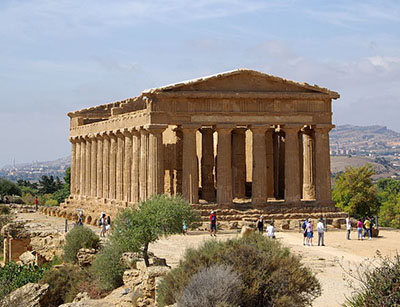 |
Even temples that Jesus himself had visited, such as the Æskelepium
in Jerusalem, were replaced by Christian churches2.
Numerous hilltop temples dedicated to Hermes (Mercury) were
replaced by churches dedicated to St Michael. A temple to Apollo
at Monte Cassino was destroyed by followers of St Benedict
in the sixth century, and a monastery was built in its place.
Many future saints assisted in such destruction. St Martin of
Tours, for example, was a keen destroyer of other people's holy
shrines — attacking them with a pickax. Saints Justa and
Rufina won their martyrdom by vandalising an image of the goddess
Venus in Seville.
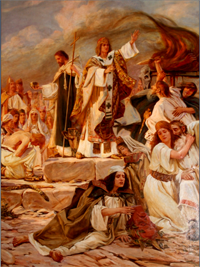  In
Western Christendom, such practices were encouraged by Pope
Gregory I, who reigned between 590 and 604. In 609 Pope Boniface
IV turned the Pantheon in Rome into a church. It had been dedicated
to all the Olympian gods; now it was dedicated to St Mary and
all the Christian martyrs. Another Roman temple, probably dedicated
to Hercules, was preserved because it was converted into a Christian
church. It is now known, mistakenly, as the Temple of Vesta.
Another one, probably dedicated to Portunus, survived for the
same reason and is known, again mistakenly, as the Temple of
Fortuna Virilis. In
Western Christendom, such practices were encouraged by Pope
Gregory I, who reigned between 590 and 604. In 609 Pope Boniface
IV turned the Pantheon in Rome into a church. It had been dedicated
to all the Olympian gods; now it was dedicated to St Mary and
all the Christian martyrs. Another Roman temple, probably dedicated
to Hercules, was preserved because it was converted into a Christian
church. It is now known, mistakenly, as the Temple of Vesta.
Another one, probably dedicated to Portunus, survived for the
same reason and is known, again mistakenly, as the Temple of
Fortuna Virilis.
The main targets for concerted vandalism were religious. Other
buildings were vandalised by neglect. The Flavian Amphitheatre,
now called the colosseum, had no particular interest for Christians,
since the fictions about Christian martydoms there were not
invented until a millennium latter. In contrast, there was an
interest in stopping
people being free to enjoy themselves, and by the late 6th
century a small church had been built into the structure. Stones
from the amphitheatre were pillaged for centuries during the
Christian period, especially after earthquakes loosened the
structure. Stones were taken for cardinals' palaces and churches
throughout the city of Rome. A Christian Order moved into the
north of the colosseum in the mid-14th century (where it remained
until the early 19th century). The amphitheatre's interior was
stripped of stone and its marble façade burned to make
quicklime for the mortar of more church buildings. Bronze clamps
holding the stonework together were hacked out of the walls.
Pope Sixtus V planned to turn the building into a wool factory,
with the intention of providing employment for Rome's numerous
prostitutes, his plan falling through with his death in 1590.
In 1671 Cardinal Altieri authorized the amphitheatre's use for
bullfights. In 1749, Pope Benedict XIV endorsed the idea that
the colosseums was a site where early Christians had been martyred.
This at least stopped a thousand years of Christian vandalism,
since he forbade the use of the colosseum as a quarry. (No-one
prior to the 16th century had suggested the colosseum had been
the site of Christian martydoms). The Catholic Encyclopedia
concedes that there is no evidence, yet many Christians continue
to imagine gory
martydoms there. Each Good Friday the Pope leads a torch-lit
"Way of the Cross" procession that starts at the colosseum.
|
The effect of a millennium of Christian
vandalism on the Colosseum. Other classical structures
all around the Mediterranean, many older, but located
away from Christian cities, are much better preserved
than this.
|
|
|
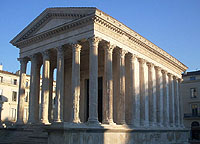  In
Gaul, Martin of Tours, a destroyer of countless temples and
sacred sites, immediately built churches or monasteries on the
sites of temples that he destroyed (Sulpicius Severus, Vita
of Sain Martin, ch xiii). The monastery at Monte Cassino was
constructed by Saint Benedict on a pagan site, in an area that
was still largely pagan. A temple of Apollo crowned the hill
there. Benedict's first act was to smash the statue of Apollo
and destroy the temple altar. He then appropriated the temple,
dedicating it to Saint Martin, and built another chapel on the
site dedicated to Saint John the Baptist. (Gregory the Great,
Life of Saint Benedict of Nursia). Montmartre in Paris takes
its name from Mons Martyris, "Mountain of the martyr",
but this is an adaption of the original name, for it was previously
Mons Martis, the "Mount of Mars". It is crowned
by Basilica of the Sacré Cœur which replaced the
temple dedicated to Mars. Nearby a church called Saint Pierre
de Montmartre replaced mercurii monte, which had been
a sacred place dedicated to Lugus, a Celtic deity equated with
Mercury by the Romans. In
Gaul, Martin of Tours, a destroyer of countless temples and
sacred sites, immediately built churches or monasteries on the
sites of temples that he destroyed (Sulpicius Severus, Vita
of Sain Martin, ch xiii). The monastery at Monte Cassino was
constructed by Saint Benedict on a pagan site, in an area that
was still largely pagan. A temple of Apollo crowned the hill
there. Benedict's first act was to smash the statue of Apollo
and destroy the temple altar. He then appropriated the temple,
dedicating it to Saint Martin, and built another chapel on the
site dedicated to Saint John the Baptist. (Gregory the Great,
Life of Saint Benedict of Nursia). Montmartre in Paris takes
its name from Mons Martyris, "Mountain of the martyr",
but this is an adaption of the original name, for it was previously
Mons Martis, the "Mount of Mars". It is crowned
by Basilica of the Sacré Cœur which replaced the
temple dedicated to Mars. Nearby a church called Saint Pierre
de Montmartre replaced mercurii monte, which had been
a sacred place dedicated to Lugus, a Celtic deity equated with
Mercury by the Romans.
|
the Apostle, Saint Philip Vanquishing
Idols (ie destroying other people's property). In his
most famous miracle, Phillip cast the Devil, in the form
of a hideous dragon, out of a statue of Mars. Philip told
the crowd that if they broke the statue and adored the
Lord's Cross, the sick would be cured and the dead would
be brought back to life.
Jean Poyer, St. Philip: Philip Vanquishing
Idols and a Demon , Hours of Henry VIII, in Latin, Illuminated
by Jean Poyer, Tours, France. The Dannie and Hettie Heineman
Collection; deposited in 1962, given in 1977. MS H.8 (fol.
177), The Morgan Library & Museum.
|
|
|
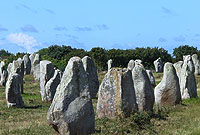  The
Abbey of Luxueil was built on the ruins of Luxovium, near to
thermal baths in Burgundy, where pagan stone images crowded
the nearby woods. The abbey church was built in triumph within
the pagan site, with a grant from a Christian officer of Childebert's
court. In Carnac, beside the Gulf of Morbihan on the south coast
of Brittany, a Catholic church was constructed on top of a Neolithic
Tumulus in order to Christianise it. The story was much the
same in what is now the South of France. A town built around
a pagan temple to Minerva is still called Minerve, and the town
built around a temple to Jupiter, fanum Jovis, is today
called Fanjeaux. The
Abbey of Luxueil was built on the ruins of Luxovium, near to
thermal baths in Burgundy, where pagan stone images crowded
the nearby woods. The abbey church was built in triumph within
the pagan site, with a grant from a Christian officer of Childebert's
court. In Carnac, beside the Gulf of Morbihan on the south coast
of Brittany, a Catholic church was constructed on top of a Neolithic
Tumulus in order to Christianise it. The story was much the
same in what is now the South of France. A town built around
a pagan temple to Minerva is still called Minerve, and the town
built around a temple to Jupiter, fanum Jovis, is today
called Fanjeaux.
|
Cemetery of Saint-Gilles-Croix-de-Vie,
in the Vendée, France - built around a pre-Christian
Menhir
|
|
|
In Britain, the Christian chronicler Geoffrey of Monmouth reported
that King Lucius had converted all of the old temples to churches.
The idea certainly had the backing of the Church. Instead of
destroying temples, they were to be sequestered for Church use.
Here is an extract from a letter written by Pope Gregory I to
Mellitus, as he was about to join Augustine of Kent among the
Anglo-Saxons:
So when almighty God has led you to the most reverend man
our brother Bishop Augustine, tell him what I have long gone
over in my mind concerning the matter of the English: that
is, that the shrines of idols amongst that people should be
destroyed as little as possible, but that the idols themselves
that are inside them should be destroyed. Let blessed water
be made and sprinkled in these shrines, let altars be constructed
and relics placed there: since if the shrines are well built
it is necessary that they should be converted from the worship
of demons to the service of the true God, so that as long
as that people do not see their very shrines being destroyed
they may put out error from their hearts and in knowledge
and adoration of the true God they may gather at their accustomed
places more readily.
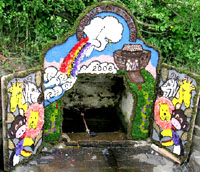  As
elsewhere in the Celtic northwest of Europe, divinities associated
with springs were transformed into local saints. Today hundreds
of local gods, relabelled as "saints" but recognized
only at the location of their own particular "holy well". As
elsewhere in the Celtic northwest of Europe, divinities associated
with springs were transformed into local saints. Today hundreds
of local gods, relabelled as "saints" but recognized
only at the location of their own particular "holy well".
They are often commemorated by annual well-dressing. In the
Peak District, the well blessing ceremony is often the signal
for the start of a week of celebrations (or 'wakes') between
the end of May and early September, with a range of events often
culminating in a carnival at the end of the week.
|
The Chalice Well, Glastonbury - another
Christianised pre-Christian holy well.
|
|
|
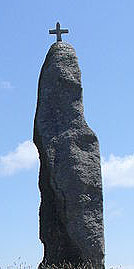  The
ancient Romans had a practice of adopting the gods of other
peoples. In a formal ceremony (exoratio) they induced
their enemies" gods to change sides before a battle with
promises of bigger sacrifices and better temples. As they conquered
new lands and acquired new gods, they sent effigies of them
back to the Temple of Capitoline Jupiter. This collection, which
should have been modern Europe's inheritance from the ancient
world, disappeared in Christian times. Countless other works
of art from all over the known world were also lost under Christian
rule. "Lost" is the conventional euphemism to cover
anything from willful negligence to deliberate seeking out and
destruction. Some classical art survived in the Eastern Empire,
especially in Constantinople. But when the Western Christians
besieged and took the city in 1204, they immediately set about
pillaging these ancient treasures, and destroying those that
they could not carry away. Nicetus, a contemporary Greek writer,
listed some of the treasures: statues of Juno, of Paris and
Venus, of Bellerophon, of Hercules, of Helen, of the Sphinxes,
and many others. Some of these statues were huge: four horses
had trouble dragging away the head of the statue of Juno. The
statue of Hercules (by Lysimachus) was so large that in girth,
the statue's thumbs were equal to a man's waist. Bronze work
was broken up and melted down so that it could be transported
more easily; marble work was simply vandalised. Much of the
loot ended up in St Mark's Basilica in Venice, which to this
day is a treasure house of Byzantine art — from the golden
chalices and reredos (altar screens) to the emperors carved
in porphyry and the four magnificent gilt horses. The
ancient Romans had a practice of adopting the gods of other
peoples. In a formal ceremony (exoratio) they induced
their enemies" gods to change sides before a battle with
promises of bigger sacrifices and better temples. As they conquered
new lands and acquired new gods, they sent effigies of them
back to the Temple of Capitoline Jupiter. This collection, which
should have been modern Europe's inheritance from the ancient
world, disappeared in Christian times. Countless other works
of art from all over the known world were also lost under Christian
rule. "Lost" is the conventional euphemism to cover
anything from willful negligence to deliberate seeking out and
destruction. Some classical art survived in the Eastern Empire,
especially in Constantinople. But when the Western Christians
besieged and took the city in 1204, they immediately set about
pillaging these ancient treasures, and destroying those that
they could not carry away. Nicetus, a contemporary Greek writer,
listed some of the treasures: statues of Juno, of Paris and
Venus, of Bellerophon, of Hercules, of Helen, of the Sphinxes,
and many others. Some of these statues were huge: four horses
had trouble dragging away the head of the statue of Juno. The
statue of Hercules (by Lysimachus) was so large that in girth,
the statue's thumbs were equal to a man's waist. Bronze work
was broken up and melted down so that it could be transported
more easily; marble work was simply vandalised. Much of the
loot ended up in St Mark's Basilica in Venice, which to this
day is a treasure house of Byzantine art — from the golden
chalices and reredos (altar screens) to the emperors carved
in porphyry and the four magnificent gilt horses.
|
The Triumphal Quadriga, is a set of bronze
statues of four horses, originally part of a monument
in Constantinople, depicting a quadriga (a four-horse
carriage used for chariot racing) The horses were placed
on the facade, on the loggia above the porch, of St Mark's
Basilica in Venice, northern Italy having been looted
during the sack of Constantinople in 1204. The sculptures
have been removed from the facade and placed in the interior
of St. Mark's for conservation purposes, with replicas
in their position on the loggia.
|
|
|
Much of what survived the vandalism throughout Western Christendom
did so either because of pagan care or Christian ignorance.
The Capitoline Venus, a Roman copy of Praxiteles" Aphrodite
of Cnidos, was hidden apparently to avoid its destruction by
Christians. It was found, walled up, in the seventeenth century.
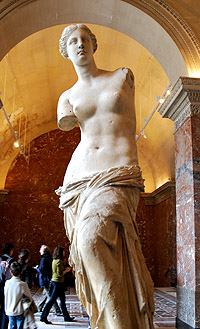  Another
Aphrodite, dug up on the Greek island of Milos in 1820, is now
celebrated as the Aphrodite of Milos, or more commonly the Venus
de Milo. Even missing her arms (which were broken after
the statue was found) she is one of the most famous statues
in the world. She is now in the Louvre, and is shown on the
right. Another
Aphrodite, dug up on the Greek island of Milos in 1820, is now
celebrated as the Aphrodite of Milos, or more commonly the Venus
de Milo. Even missing her arms (which were broken after
the statue was found) she is one of the most famous statues
in the world. She is now in the Louvre, and is shown on the
right.
The arms and original plinth were lost following her discovery.
The statue, in marble, was created sometime between 130 and
100 BC. From an inscription on its plinth, noted before it disappeared,
she is thought to be the work of Alexandros of Antioch. According
to modern experts she is not in the same class as Praxiteles"
original Aphrodite, which is, of course, "lost".
Other statues, like Laocoön and his sons, and the Apollo
Belvedere, both now in the Vatican Museum, were rediscovered
during the Renaissance. So was the Farnese Hercules by Glycon,
rediscovered in 1540. Some statues were vandalised but not destroyed.
For example a statue of Isis in Rome now leads a second life
as the liberally bosomed "Madama Lucrezia".
  Not
only religious statues fell victim to the Christians. Early
Christians destroyed secular statues and inscriptions. The great
Church historian Eusebius
gloated that Caesar Maximian was "the first whose complimentary
inscriptions and statues, and everything else that is customarily
set up, were thrown down as being reminders of a foul monster"3.
Vandalised statues of him were left as objects for jests and
horseplay for anyone who might want to insult and abuse them.
His portraits were destroyed and so were those of his family
— some were flung from a height and smashed, others had
their faces blacked out and damaged beyond repair. Similar fates
befell others who were not sufficiently sympathetic to the Christian
cause. Unsympathetic people were executed, and all memorials
to their existence destroyed. Not
only religious statues fell victim to the Christians. Early
Christians destroyed secular statues and inscriptions. The great
Church historian Eusebius
gloated that Caesar Maximian was "the first whose complimentary
inscriptions and statues, and everything else that is customarily
set up, were thrown down as being reminders of a foul monster"3.
Vandalised statues of him were left as objects for jests and
horseplay for anyone who might want to insult and abuse them.
His portraits were destroyed and so were those of his family
— some were flung from a height and smashed, others had
their faces blacked out and damaged beyond repair. Similar fates
befell others who were not sufficiently sympathetic to the Christian
cause. Unsympathetic people were executed, and all memorials
to their existence destroyed.
The West's patrimony from classical times is tiny compared
to what it might have been if the early Christian authorities
had allowed artistic taste to encroach on their religious prejudices4.
The little that remains has survived despite the efforts of
the more zealous Christians. Statues were buried, or walled
up, or cast into the sea to avoid the Christian picks and hammers.
Had the Christians been more competent detectives, and less
ignorant about the subject matter, then the whole patrimony
would have been "lost". An equestrian statue of Marcus
Aurelius in the Campidoglio in Rome survived because Christians
mistook it for a statue of their hero Constantine.
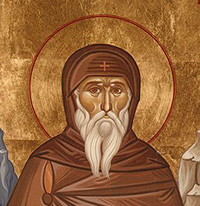  We
can often tell that Christians were responsible for vandalising
statues first because they made a point of disfiguring the face
(as Moslems vandals still do), and secondly because they would
often carve crosses on the face, most commonly a cross in the
middle of the forehead, to somehow Christianise the statue.
Making crosses on foreheads is a common Christian practice.
It is still done with water in the course of baptisms, with
ash on Ash Wednesday, and with paint on the skulls of dead monks.
It was previously done with a red hot branding iron on the foreheads
of supposed heretics. Below are a few examples of statues vandalised
by Christians. We
can often tell that Christians were responsible for vandalising
statues first because they made a point of disfiguring the face
(as Moslems vandals still do), and secondly because they would
often carve crosses on the face, most commonly a cross in the
middle of the forehead, to somehow Christianise the statue.
Making crosses on foreheads is a common Christian practice.
It is still done with water in the course of baptisms, with
ash on Ash Wednesday, and with paint on the skulls of dead monks.
It was previously done with a red hot branding iron on the foreheads
of supposed heretics. Below are a few examples of statues vandalised
by Christians.
|
This statue of the goddess Aphrodite
found at the Agora at Athens
bears the hallmarks of Christian vandals,
including crosses carved on the forehead and chin.
|
This statue of Germanicus
(Germanicus Julius Caesar (15 BC – AD 19)
bears the hallmarks of Christian vandals,
including a cross carved on the forehead
|
|
|
|
|
|
|
|
This statue of Livia Drusilla, wife of
the Emperor Augustus also bears the hallmarks of Christian
vandals
|
Another example from Turkey.
Unidentified
|
|
|
|
|
|
|
|
Statue of Augustus from Ephesus. Now
in the Ephesus Museum, Selcuk, Turkey.
|
Another example from Ephesus.
Unidentified
|
|
|
|
  Religiously
inspired philistinism extended to all corners of life. Christians
were responsible for putting a stop to the original Olympic
Games, of which they disapproved. The famous statue of Zeus
at Olympia, wrought in gold and ivory, one of the seven wonders
of the world, was carted off to Constantinople where it was
later destroyed. (It is thought to have looked like the image
shown on the right). The workshops of Phidias, the sculptor
of the statue of Zeus, were converted into a Christian church. Religiously
inspired philistinism extended to all corners of life. Christians
were responsible for putting a stop to the original Olympic
Games, of which they disapproved. The famous statue of Zeus
at Olympia, wrought in gold and ivory, one of the seven wonders
of the world, was carted off to Constantinople where it was
later destroyed. (It is thought to have looked like the image
shown on the right). The workshops of Phidias, the sculptor
of the statue of Zeus, were converted into a Christian church.
Other wonders of the world suffered similarly. According to
Christian sources, the Temple of Diana (Artemis) near Ephesus
was destroyed along with the goddess's statue, first damaged
by Saint John the Apostle, and then flattened by Saint John
Chrysostom in 401, following a Christian emperor's Edict
of Thessalonica4a.
The stones were used for a "tomb" for St John and
a bath-house. A cross was raised on the spot where Diana's statue
had stood. Another wonder of the world, the Mausoleum at Helicarnassus,
was cannibalised to build a crusader castle, which still stands
near the harbour of modern Bodrum in Turkey.
| |
One of the Seven Wonders of the World,
the Mausoleum (left),
before it was dismantled by Christian crusaders to build
a crusader castle (right)
|
| |
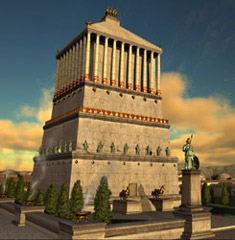 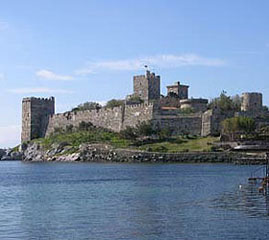 |
The building of temple of Diana (or Artemis) at Effesus had
been a 120-year project started by King Croesus of Lydia. It
was described by Antipater of Sidon, who compiled a list of
the Seven Wonders:
I have set eyes on the wall of lofty Babylon on which is
a road for chariots, and the statue of Zeus by the Alpheus,
and the hanging gardens, and the colossus of the Sun, and
the huge labour of the high pyramids, and the vast tomb of
Mausolus; but when I saw the house of Artemis that mounted
to the clouds, those other marvels lost their brilliancy,
and I said, "Lo, apart from Olympus, the Sun never looked
on aught (anything) so grand". (Antipater, Greek Anthology
[IX.58])
It was destroyed by Christians, and is now an empty field.
Some stones used to build a nearby church, other carted off
to Contantinople. Some of the columns in Hagia Sophia came from
the temple of Artemis, and statues and other decorative elements
ended up in the Christian capital..
An inscription at Ephesus confirms the role of Christians in
the vandalism, in particular a Christian called Demeas:
Destroying the delusive image of the demon Artemis, Demeas
has erected this symbol of Truth, the God that drives away
idols, and the Cross of priests, deathless and victorious
sign of Christ.
|
A reconstruction of what the Temple of
Artemis would have looked like, and a photograph of the
site today (the pillar is reconstructed from stones on
the site). Quality stones were carted off to Contantinople,
others used in churches and eventually building like those
in the background.
|
|
|
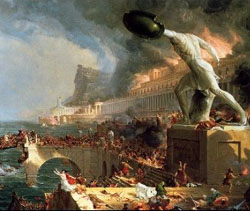  During
the reign of the Christian Emperor Theodosius I, the library
at Alexandria was burned. For years bands of Christian monks
had been sweeping down from their desert monasteries to destroy
shrines and temples. They ransacked houses, destroying all non-Christian
religious objects. In 391 when they burned down the Temple to
Serapis they also managed to set fire to the nearby library—
the greatest library in the Western world. Some estimates put
the number of volumes destroyed at 700,000 (although enough
volumes remained for later Muslims to enjoy more fires when
they arrived in 642). The end of progress in ancient mathematics
is conventionally dated as 415, the year Hypatia
was murdered by Christians in the same city, during the reign
of the next bishop. The great tradition of learning at Alexandria
came to an end in 517 when its world famous School of Philosophy
was closed down. Elsewhere, rival Christian schools had to be
eliminated too. In 489 the Emperor Zeno had closed the schools
of Edessa. The end of ancient philosophy can be equated with
the closing of the Academy and other philosophical Schools in
Athens by the Christian Emperor Justinian in 529. Any possibility
of intellectual opposition was now eliminated. During
the reign of the Christian Emperor Theodosius I, the library
at Alexandria was burned. For years bands of Christian monks
had been sweeping down from their desert monasteries to destroy
shrines and temples. They ransacked houses, destroying all non-Christian
religious objects. In 391 when they burned down the Temple to
Serapis they also managed to set fire to the nearby library—
the greatest library in the Western world. Some estimates put
the number of volumes destroyed at 700,000 (although enough
volumes remained for later Muslims to enjoy more fires when
they arrived in 642). The end of progress in ancient mathematics
is conventionally dated as 415, the year Hypatia
was murdered by Christians in the same city, during the reign
of the next bishop. The great tradition of learning at Alexandria
came to an end in 517 when its world famous School of Philosophy
was closed down. Elsewhere, rival Christian schools had to be
eliminated too. In 489 the Emperor Zeno had closed the schools
of Edessa. The end of ancient philosophy can be equated with
the closing of the Academy and other philosophical Schools in
Athens by the Christian Emperor Justinian in 529. Any possibility
of intellectual opposition was now eliminated.
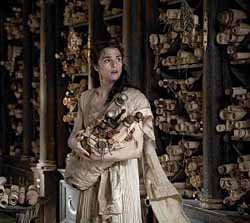  Philosophy
was considered dangerous to Christianity. Philosophers were
persecuted and their books burned. Such was the persecution
that men of learning were driven to destroy their own libraries
rather than risk a volume being seen by a Christian informer.
The few intellectual Christians that there were had to be careful
of offending the sensibilities of the less intellectual majority.
The philosopher Boethius for example was killed by the pious
Christian Ostrogoth Theodoric in the sixth century. He is reputed
to have met his end by having a bowstring tightened around his
temples until his eyes protruded from his head. His death marked
the end of the classical tradition of learning. Philosophy
was considered dangerous to Christianity. Philosophers were
persecuted and their books burned. Such was the persecution
that men of learning were driven to destroy their own libraries
rather than risk a volume being seen by a Christian informer.
The few intellectual Christians that there were had to be careful
of offending the sensibilities of the less intellectual majority.
The philosopher Boethius for example was killed by the pious
Christian Ostrogoth Theodoric in the sixth century. He is reputed
to have met his end by having a bowstring tightened around his
temples until his eyes protruded from his head. His death marked
the end of the classical tradition of learning.
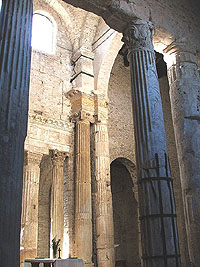  Any
pagan work that referred to Jesus, and any works by Christians
who could not accept the theology agreed atthe latest Church
Council, were suppressed. The only acceptable literature was
literature that conformed to the official Christian line of
the moment. Gospels that did not fit requirements were discarded,
and their existence denied. Other writings were creatively edited.
Works by educated pagan authors were destroyed along with those
of Christians whose views were not currently regarded as orthodox.
Histories were either "lost" or doctored to make them
acceptable. Any
pagan work that referred to Jesus, and any works by Christians
who could not accept the theology agreed atthe latest Church
Council, were suppressed. The only acceptable literature was
literature that conformed to the official Christian line of
the moment. Gospels that did not fit requirements were discarded,
and their existence denied. Other writings were creatively edited.
Works by educated pagan authors were destroyed along with those
of Christians whose views were not currently regarded as orthodox.
Histories were either "lost" or doctored to make them
acceptable.
Numerous works by pagan authors were known during the early
centuries of the Church, and many of them were subsequently
destroyed or otherwise "lost". We know for example
that several biographies of Pythagoras were written. All have
been "lost". One of the most famous Roman writers,
Aulus Cornelius Celsus, wrote De Artibus
— a work that is known to have covered agriculture,
military theory, philosophy, law and medicine. He was a highly
regarded thinker who had a poor opinion of the Christians, and
unsurprisingly his work has disappeared. Parts of his medical
writings were rediscovered in the Middle Ages, and from these
it is possible to gauge the scale of our loss.
Often we know that works were still current in the early years
of Christianity: for example St Augustine is known to have read
Cicero's Hortensius, then part of the school curriculum
but since "lost". Some pagan tracts were given Christian
prefaces and conclusions, and presented as original documents.
Thus the letter of Eugnostos the Blessed was converted
into an account of the wisdom revealed by Jesus to the disciples
after his death. Anything that could not be cannibalised in
this way was discarded. Thus, no Greek secular works were preserved
in the original. Secular learning and secular art, along with
secular education, almost disappeared. Some works were recovered
during the Renaissance. Petrarch, for example, recovered other
works by Cicero. Poems by Catullus were reputedly found serving
as a bung in a Mantuan wine barrel. In the nineteenth century
Robert Curzon found "lost" works of Euclid and Plato
serving as stoppers in olive oil jars in a Coptic Monastery
(at Deir el-Suriani in the Wadi Natrum).
  Parchment
was expensive so Medieval Churchmen would sometimes take a used
one, scrape off the existing text, and reuse it - as a so-called
palimpsest. Regarding the works of pagans of the ancient world
as worthless, they destroyed, or at least thought that they
had destroyed, the works of the some of the greatest minds in
human history, to make prayer books. Modern science has been
able to recover a few important works from these Christian prayer
books. For example, in 1229 AD parchment copies of seven treatises
of Archimedes were erased and overwritten by prayers, then bound
in a Byzantine prayerbook (a euchologion) by a priest called
Johannes Myronas. Myronas understood Greek, so must have known
what he was doing. Of the seven treatises by Archimedes, two
are otherwise unknown (The The Method of Mechanical Theorems
and the Stomachion) and one (On Floating Bodies)
is unknown in the original Greek, the language in which Archimedes
wrote. Working in Jerusalem, the priest had vandalised not only
treatises by Archimedes to make his prayerbook, but also other
works, including 10 folios of the Attic orator Hyperides dating
from the fourth century BC, one of which contained an extremely
important speech that has not otherwise been preserved.5.
This copy of Archimedes Method was found in 1906. There
is no way of telling how many other such palimpsests there were
on which Christians did a more thorough job, and so will never
be discovered. Parchment
was expensive so Medieval Churchmen would sometimes take a used
one, scrape off the existing text, and reuse it - as a so-called
palimpsest. Regarding the works of pagans of the ancient world
as worthless, they destroyed, or at least thought that they
had destroyed, the works of the some of the greatest minds in
human history, to make prayer books. Modern science has been
able to recover a few important works from these Christian prayer
books. For example, in 1229 AD parchment copies of seven treatises
of Archimedes were erased and overwritten by prayers, then bound
in a Byzantine prayerbook (a euchologion) by a priest called
Johannes Myronas. Myronas understood Greek, so must have known
what he was doing. Of the seven treatises by Archimedes, two
are otherwise unknown (The The Method of Mechanical Theorems
and the Stomachion) and one (On Floating Bodies)
is unknown in the original Greek, the language in which Archimedes
wrote. Working in Jerusalem, the priest had vandalised not only
treatises by Archimedes to make his prayerbook, but also other
works, including 10 folios of the Attic orator Hyperides dating
from the fourth century BC, one of which contained an extremely
important speech that has not otherwise been preserved.5.
This copy of Archimedes Method was found in 1906. There
is no way of telling how many other such palimpsests there were
on which Christians did a more thorough job, and so will never
be discovered.
The loss through Christian vandalism - both deliberate and
casual - is incalculable, but the scale of it can be estimated
from the shreds that survive. Tacitus's surviving Histories
and Annals are both incomplete. One manuscript of Lucretius's
De Rerum Natura, "On the Nature of the Universe",
survived the Dark Ages. Livy's lost works include his 142 volume
History of Rome of which only a small part has survived.
Pliny the Elder wrote numerous works of which only his Historia
Naturalis survives. There is of course no way of knowing
how many hundreds or thousands of important works have vanished
completely — without even a passing reference in any surviving
work. It was not only classical works that were destroyed. When
they had the opportunity to do so Christians burned Jewish and
Muslim books as well. After the Muslim city of Tripoli surrendered
to the crusaders in 1109, the great library of Banu Ammar ,
the finest in the Muslim world, was burnt to the ground with
all of its contents.
Some works were preserved because they were taken out of the
reach of orthodoxy. When persecuted Nestorians fled eastward,
they took ancient works with them. They enjoyed much greater
freedom under Zoroastrian and Muslim rulers, and established
prominent communities in what are now Iraq and Iran. Along with
other refugees they translated the writings of Greek philosophers.
For 1,000 years these writings were lost to the West. When they
were eventually retranslated from Arabic into Latin they fired
the revival of learning that we know as the Renaissance. It
was through this route that the works of Aristotle were preserved.
Other works survived in other ways. In 1895 the ancient rubbish
dumps of Oxyrhynchus in Egypt yielded, amongst other things,
a forgotten song by Sappho and fragments of "lost"
plays by Aeschylus and Sophocles.
|
A common claim made by Christians is that Christianity
single-handedly kept alight the guttering flame of learning
during the Dark Ages, in the face of marauding wild barbarians.
The truth is almost the exact opposite. The Church was
largely responsible for plunging western Europe into ignorance
and darkness. Towards the end of the fourth century for
example Goths destroyed much of the Western Empire, including
great cities like Delphi and Athens. But these Goths were
not the pagan barbarians of traditional history books,
they were Christians. These barbarians marched with bibles
at the head of their armies. When they besieged Rome it
was not, as is often supposed, pagans besieging civilised
Christians but for the most part Christians besieging
civilised pagans. To be sure there were some Christians
in the city, but there is no reason to suppose that their
faith was stronger than that of their bishop. Their bishop
(now regarded as a Pope) consented to pagan sacrifices
on the altar of St Peter's in order to save the city from
the Christian hordes at its gates.
|
|
The Sack of Rome by the Barbarians
in 410
Joseph-Noël Sylvestre, 1890
It is not often mentioned that these barbarians
were Christians
|
|
|
|
The Visigoths in Spain and southern Gaul, and the Ostrogoths
in Italy were also Arian Christians. So too, the Vandals who
plundered Gaul, Spain and North Africa were bible-toting Christian
believers. Popular stories about pagan barbarians sacking Rome
are pure fantasy. Rome was still in good shape until the middle
of the sixth century when the Christian Emperor Justinian tried
to reconnect Italy to the Empire. The city was repeatedly besieged
and plundered by Christian forces. The Christian Emperor Constans
II completed the destruction in 664 when he removed the last
items of value, including any metal he could lay hands on, not
only statues but also bronze fittings and lead roofs —
even metal clamps and ties that kept the stone walls together.
Rain and weather did further damage, but there was still enough
left for later Christians to exceed the efforts of all their
predecessors.
Europe
... the popes wantonly ruined more of ancient Rome than Goths
or Saracens had ever managed.
Guidebook to Rome6
The true torchbearers during the Dark Ages were Arabs, Jews,
heretics and pagans who kept alive pre-Christian teachings.
In western Europe Christianity enforced a monopoly of thought,
and the consequence of this was that Western Christendom spent
the Middle Ages in abject ignorance, regarded by Byzantines
and Muslims alike as hopeless philistines. Pope Paul II, a nepotist
and murderer, epitomised Western Christianity at the end of
the medieval period. When in 1466 the historian Bartolomeo Platina
commented on his ignorance, His Holiness had him imprisoned
and tortured. The same pope suppressed the Roman Academy, which
he thought encouraged paganism, and also banned the reading
of ancient poets by Roman children.
How great was Europe's cultural loss can be assessed by comparing
the state of civilisation under the ancient Greeks with that
of Christendom at the close of the Middle Ages, almost 2,000
years later. All of these areas of cultural endeavour had flourished
under the Greeks — many of them are discussed in more detail
elsewhere on this website.
| Area |
Fate under Christian hegemony |
| Architecture: |
Stone buildings that had been built extensively for private
and public purposes were now limited to military and ecclesiastical
structures. Existing public buildings (forums, libraries,
odeons, theatres, museums, stadia, hippodromes, circuses,
schools, gymnasia, temples, baths, Roman amphitheatres
etc.) were often vandalised or destroyed. Many building
techniques were forgotten.
|
| Education: |
Where even the poor had been taught to read and write
in pagan times, and the rich had been expected to build
public schools, education became a Church monopoly, and
was denied to all except prospective priests and sons
of the rich. The syllabus was restricted to Christian
indoctrination.
|
| Dance: |
Dance was prohibited as pagan and tending
to promote lust. |
| Democracy: |
Democracy was condemned as un-Christian, since
the Bible presupposed kingdoms. |
| History: |
Factual history was replaced by fabrications and propaganda
(such as “legends”), except for sympathetic
chronicles that did not reflect badly on the Church. Unsympathetic
or objective histories were "lost".
|
| Law: |
Law was converted from an instrument of justice to a
system featuring trials by ordeal, frequently serving
the interests of the Church and denying the principles
of natural justice. Inequality was a fundamental principle
of ecclesiastical law.
|
| Literature: |
All literature, including the Bible, was banned to the
population at large. The few who were allowed to learn
to read were restricted to prayer books and Christian
Legends presented as fact. Other books were generally
destroyed or hidden away in monasteries.
|
| Mathematics
|
This was limited within the Church to the arithmetic
necessary to calculate the date of Easter. Otherwise it
was treated with suspicion or hostility.
|
| Medicine: |
All medical progress was halted. Illness was considered
to be a punishment for sin. Hygiene and public health
were abandoned as unchristian
|
| Music & Singing: |
Music and singing were periodically restricted to Church
music. Otherwise they were regarded as satanic. Classical
opera died out under the Christian hegemony — it
was re-introduced in the sixteenth century.
|
| Natural
history: : |
The study of nature, popular in the ancient world, stagnated
until the Enlightenment. Research was suppressed until
then because the Church insisted on a literal interpretation
of the Bible and its infallibility as a handbook of all
world knowledge.
|
| Painting and Art: |
All representation was first banned, then restricted
to religious themes from the fifth century. Existing non-Christian
art was destroyed. The rules of perspective, known in
Antiquity, were "lost" for a thousand years
(ie during the hegemony of the Church). They were rediscovered
by mathematician and painter Piero della Francesca (1415–1492)
at the dawn of the Renaissance. In 1563, the Council of
Trent confirmed Art as a conformist naturalistic propaganda
tool.
|
| :Philosophy:
|
A Church monopoly was established. The subject was then
reduced to scholasticism.
Existing philosophical works were destroyed. Genuine philosophers
were censored, persecuted and sometimes killed. No significant
progress (except by “heretics”) was to take
place from the murder of Hypatia
until Cosimo de" Medici revived ancient philosophy
with his Platonic Academy in Florence7
|
| Public Service: |
The charitable endowment of public buildings (schools,
libraries, theatres, sports stadia, baths, horse racing
cources, etc.) ceased almost completely when the Church
enjoyed total control. Almost every village in Europe
has a medieval church, generally built in better materials
than any other local building. A vanishingly small number
have comparable church built schools, hospitals or other
useful public buildings. The first modern public library
was founded by Cosimo de' Medici, “godfather”
to the Renaissance8
|
| Sculpture: |
Non-religious sculpture ceased to be produced. The best
examples from antiquity were "lost". Inferior
material was produced for the Church, generally for propaganda
purposes. Nothing comparable in quality to classical work
was produced until the Renaissancet.
|
| Sport: |
Sports were suppressed, along with international sporting
events. They were replaced by various kinds of animal
torture and pastimes too local to be controlled by the
Church.
|
| Theatre: |
Acting was banned, except for propaganda purposes: religious
ceremonies, mystery plays and morality plays.
|
| Public Health |
Public baths, sophisticated aquaducts and
sewers were all destroyed or allowed to fall into desuetude
(the only exception being baths which were preserved in
monasteries for the use of monks) |
| Infrastructure |
Streets and viaducts were used but not maintained. They
survived into secular times only because they had been
so well built.
|
It is notable that all of these areas flourished again as the
hand of the Church was progressively relaxed, prized off by
Renaissance Humanists, Enlightenment thinkers, scientists and
secular philosophers.
|
Typical Classical sculpture
before the Christian era
|
Typical Christian sculpture,
after a millennium of Christian hegemony
|
|
|
|
  Church
vandalism continued for centuries after the Middle Ages. The
canopy under the dome of the present St Peter's is made from
200 tons of bronze stripped from the Pantheon in the sixteenth
century (the rest reputedly went to make papal canon). Construction
of St Peter's had been started by Bramante. He destroyed much
that could have been preserved from the old basilica, and pillaged
various old buildings for marble and other materials. Raphael,
who took over after his death, called him Ruinante.
Roman Christians were not content with destroying their own
city. Rome, the Eternal Parasite, is still furnished
with treasures pillaged from elsewhere. There are for example
more large obelisks in Rome than remain in Egypt. Church
vandalism continued for centuries after the Middle Ages. The
canopy under the dome of the present St Peter's is made from
200 tons of bronze stripped from the Pantheon in the sixteenth
century (the rest reputedly went to make papal canon). Construction
of St Peter's had been started by Bramante. He destroyed much
that could have been preserved from the old basilica, and pillaged
various old buildings for marble and other materials. Raphael,
who took over after his death, called him Ruinante.
Roman Christians were not content with destroying their own
city. Rome, the Eternal Parasite, is still furnished
with treasures pillaged from elsewhere. There are for example
more large obelisks in Rome than remain in Egypt.
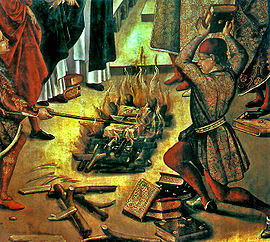  Book
burning — that favourite activity of the Christians throughout
the Dark Ages — continued throughout the Middle Ages. Medieval
Christians claimed that Holy Books could be easily identified
because they would not burn. It was the same technique supposedly
used by early Christians to determine the cannon of the New
Testament - Heretical books burned: Holy books did not. As Voltaire
noted, it is a great pity that this simple method of distinguishing
the two no longer works - Holy Testaments have burned just as
well as heretical ones since the end of the Middle Ages. In
any case, this supposed method enabled Churchmen like Saint
Dominic to destroy any book they wanted, and acclaim their vandalism
as proof of heretical content. Book
burning — that favourite activity of the Christians throughout
the Dark Ages — continued throughout the Middle Ages. Medieval
Christians claimed that Holy Books could be easily identified
because they would not burn. It was the same technique supposedly
used by early Christians to determine the cannon of the New
Testament - Heretical books burned: Holy books did not. As Voltaire
noted, it is a great pity that this simple method of distinguishing
the two no longer works - Holy Testaments have burned just as
well as heretical ones since the end of the Middle Ages. In
any case, this supposed method enabled Churchmen like Saint
Dominic to destroy any book they wanted, and acclaim their vandalism
as proof of heretical content.
When 240 wagonloads of Jewish books were burned in 1242 the
incident provoked an official inquiry. A committee, including
the great churchman Albertus Magnus, was appointed by Pope Innocent
IV. The committee approved of the destruction of the books.
As a result more mass burnings were held. Talmudic studies were
banned, and centres of Jewish scholarship were destroyed. In
1415 a papal bull forbade Jews to possess or read the Talmud.
Hundreds of thousands of Jewish books, including rare manuscripts,
were burned in Italy by the Roman Inquisition. In 1629 an Italian
cardinal could boast of having collected 10,000 Jewish books
for destruction9.
Classical books, if discovered, were burned or hidden, Arabic
books were burned, heretical books were burned, books exposing
forgery and corruption were burned, books containing original
thought were burned. Not only were factual information and opinions
in need of suppression. Some churchman could generally be found
to condemn any item of innocent fun, amusement, interest or
beauty. In 1497 the Christian citizens of Florence were inspired
by the Friar Savonarola (and armed guards) to burn material
possessions. Countless works of art went onto a "bonfire
of the vanities". Pictures, books, musical instruments,
songs, poems, even jewellery — all were consigned to the
flames. Known books included works by Ovid, Cicero, Boccaccio,
Petrarch, and Poliziano. One bonfire, lit on Shrove Tuesday
1497, was 100 feet wide and sixty feet high. The crowd sang
Te Deum laudamus as it burned.
|
This is Chetham's Library in Manchester.
It i is the oldest free public reference library in the
United Kingdom. It was established in under the will of
Humphrey Chetham (1580–1653) and has been in continuous
use since 1653. It operates as an independent charity,
open to readers and visitors free of charge. The Churches
could have created such libraries throughout Europe, but
never saw the need to do so. The idea of enouraging the
masses to read was traditionally seen as undesirable.
|
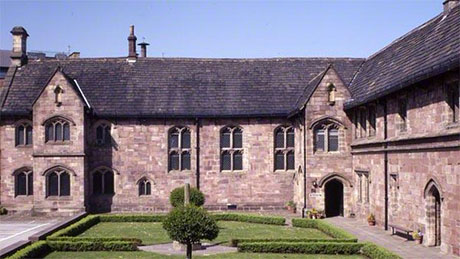 |
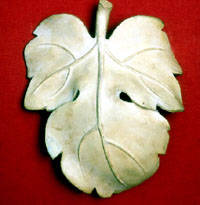  Soon
the Church would be suppressing nudity too. Paul IV (pope 1555-1559),
defaced many statues and paintings by covering up or painting
over disconcerting genitals. Michelangelo's Last Judgement
in the Sistine Chapel was sanitised in this way, the artist
who carried out the task, Daniel of Volterra, earning the nickname
il braghettone ("the trouserer"). Innocent X
(pope 1644-1655) installed metal fig leaves on the nude statues
in the Vatican. Soon
the Church would be suppressing nudity too. Paul IV (pope 1555-1559),
defaced many statues and paintings by covering up or painting
over disconcerting genitals. Michelangelo's Last Judgement
in the Sistine Chapel was sanitised in this way, the artist
who carried out the task, Daniel of Volterra, earning the nickname
il braghettone ("the trouserer"). Innocent X
(pope 1644-1655) installed metal fig leaves on the nude statues
in the Vatican.
Numerous keen Christians have occupied their time in chipping
the genitals off male statues throughout Christendom. This is
one of the areas where Protestants and nonconformists have excelled
Roman Catholics. In the nineteenth century notable figures like
Comstock campaigned in the USA to protect the public from much
of the greatest art ever produced. Others established pressure
groups to clothe animals and to suppress other manifestations
of vice.
  Such
distinctively religeous attitudes persisted throughout the twentieth
century and beyond. In 1996 devout American Christians mounted
a campaign to have two statues used at the Olympic Games covered
up. They were offended that representations of human figures
should be furnished with genitalia. Not so long before that
the Australian authorities had impounded a copy of Michelangelo's
David on the grounds that it was indecent. In 2005, officials
in Bartholomew County, Indiana, required copies of classical
art to be moved out of public view because they would be considered
obscene under Indiana law. The statutes included copies of Michelangelo's
David and the Venus de Milo. Such
distinctively religeous attitudes persisted throughout the twentieth
century and beyond. In 1996 devout American Christians mounted
a campaign to have two statues used at the Olympic Games covered
up. They were offended that representations of human figures
should be furnished with genitalia. Not so long before that
the Australian authorities had impounded a copy of Michelangelo's
David on the grounds that it was indecent. In 2005, officials
in Bartholomew County, Indiana, required copies of classical
art to be moved out of public view because they would be considered
obscene under Indiana law. The statutes included copies of Michelangelo's
David and the Venus de Milo.
Ancient monuments throughout Europe also suffered at the hands
of Christians. Following the methods advocated by Pope Gregory
I, wherever the Church spread it destroyed or took over the
sites held holy by the local inhabitants. In Britain the traditional
holy sites included yew groves, which helps to explain why yew
trees are so common in English churchyards to this day. Neolithic
stones were revered too. Churches were often built next to them
in the hope that they would inherit the stones" sanctity.
In this way the Church could represent itself as belonging to
an existing sacred tradition. Christian churches were sometimes
built within ancient circles.
|
St Michael's Tower, a Christian edifice
on Glastenbury Tor in England.
It was built here because of the Tor's significance in
Celtic and even older religions.
|
|
|
In later centuries, when the population had been converted
and the earlier beliefs forgotten the Church could denounce
the ancient stones as satanic, and set about destroying them.
Many ancient standing stones were vandalised by the Church on
this pretext. Lacking the elementary technology for splitting
them, priests often had them tipped over or buried in pits.
Later, they rediscovered an ancient method of breaking up large
stones. They lit a fire around the stones, then doused them
with water so that the thermal shock splintered them. The practice
was called stone killing. It was popular wherever ancient
stones were to be found, and its religious significance was
clearly recognised.
Everywhere the Church took hold, it made a point of either
adopting local gods as saints or denouncing them as satanic.
Sacred trees, groves and other sites were desecrated everywhere.
St Martin had felled holy trees in Gaul in the fourth century.
John of Ephesus felled them in Asia Minor in the sixth century.
Other zealous Christians committed arboreal genocide all around
the Mediterranean. In the 770s a holy wood at Eresburg, also
sacred to the Saxons, was taken in battle by Charlemagne. The
victorious Christian forces destroyed the holy Irminsul, a tall
pillar in the wood representing the world-tree Yggdrasil. Surviving
Saxon boys were carried off to be indoctrinated and trained
as missionaries.
|
A modern reconstruction of Irminul.
This is what Irminsul is thought to have looked like
|
The destruction of Irminsul by Charlemagne
(1882) by Heinrich Leutemann
|
|
|
|
Sometimes, for policy reasons, sacred places were tolerated
for a while, but the end result was much the same. As Robert
Graves explained of Ireland:
...the age of toleration did not last long; once Irish princes
lost the privilege of appointing bishops from their own sept,
and iconoclasts were politically strong enough to begin their
righteous work, the axe rose and fell on every sacred hill10
Prince Vladimir's forcible conversions in Russia around AD
1000 were complemented by the destruction of an image of the
god Perun, at Kiev. Such destruction was adduced as evidence
of the powerlessness of pagan gods, although it cannot have
proved more than the destruction of Christian icons by Muslims
and other iconoclasts. It merely deprived Europe of its history.
|
Bishop Absalon topples the god Svantevit
at Arkona in 1169 proving that it was just an idol
Bishop Absalon led military crusades against the Wends,
whose crime was not to be Christian. They were forcibly
converted to Christianity and their temples and religious
icons destroyed. The same fate befell the god Rugievit
at the Wendish capital of Rügen.
|
|
|
|
|
|
Absalon, a Danish nobleman, Bishop of
Roskilde from 1158 to 1192, Archbishop of Lund from 1178
until his death in 1201, Christian warrior and vandaliser
of the holy images of non-Christians. Here he is on the
wall of the City Hall in Copenhagen, still honoured by
Christians, sword and scepter in hand. Absalon was a key
figure in the Danish policies of territorial expansion
around the Baltic Sea,
|
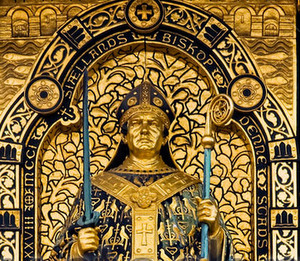 |
Darvell Gathern, the wooden image of a Welsh god, was brought
to London to be publicly burned in the 1530s. The result of
such destruction is that we now know much less about pre-Christian
European cultures than we otherwise would. We know next to nothing
about Druidism, the religion of the ancient Britons. Neither
do we know much about our Anglo-Saxon ancestors. Their extensive
writings are for the most part "lost". The only substantial
early ones that have survived, such as Beowulf, are
ones that deal with Christian themes. We know little about the
related Germanic and Norse religions either. Some of what we
do know comes from Iceland, where Christianity was late on the
scene, although even there much history was lost, including
an unknown number of Eddas (collections of folk-tales) and even
histories of the Kings of Norway written in Latin11.
Without Christianity the European patrimony from the ancient
world might have been ten times what it is; perhaps a hundred
times; perhaps a thousand times; perhaps more. We shall never
know.
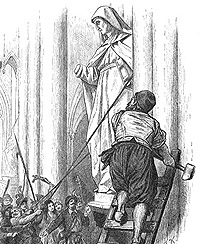  Church
vandalism was not only directed against non-Christians. Christians
have been persecuting other Christians and vandalising their
possessions for almost two thousand years - executing them for
heresy, burning their books for blasphemy, destroying their
icons as impious. It happened throughout Christendom during
the early centuries, followed by iconoclast wars in the Orthodox
Church and religious wars in the Catholic West. The tombs of
Crusader Kings of Jerusalem, once stood in the Church of the
Holy Sepulchre. Over the centuries they had not been touched
by the Moslems rulers of Jerusalem, who had every reason to
resent them. They were destroyed in the nineteenth century by
Orthodox Monks. Nor was this exceptional. When Sir Ronald Storrs,
military Governor of Jerusalem during the Great War discovered
a previously unknown Crusader grave near the south door of the
church, the Orthodox priests were so furious about it that Storrs
had the grave guarded by British soldiers12. Church
vandalism was not only directed against non-Christians. Christians
have been persecuting other Christians and vandalising their
possessions for almost two thousand years - executing them for
heresy, burning their books for blasphemy, destroying their
icons as impious. It happened throughout Christendom during
the early centuries, followed by iconoclast wars in the Orthodox
Church and religious wars in the Catholic West. The tombs of
Crusader Kings of Jerusalem, once stood in the Church of the
Holy Sepulchre. Over the centuries they had not been touched
by the Moslems rulers of Jerusalem, who had every reason to
resent them. They were destroyed in the nineteenth century by
Orthodox Monks. Nor was this exceptional. When Sir Ronald Storrs,
military Governor of Jerusalem during the Great War discovered
a previously unknown Crusader grave near the south door of the
church, the Orthodox priests were so furious about it that Storrs
had the grave guarded by British soldiers12.
Protestant reformers encouraged the removal of religious images
by invoking the Second Commandment's prohibition of idolatry
and the manufacture of graven (sculpted) images of God. Reformers
attacked statues and images. Others others were damaged or stolen
during iconoclastic riots. These Christians specifically targeted
faces of images, just as their predecessors had a thousand years
earlier.
|
Horrible Cruelties of the Huguenots,
1562
According the Catholic propaganda, Hugenots (French Protestants)
executed images of Christ on the Cross by firing squad
(an updated version of what Catholics had done to pagan
images for many centuries)
|
|
|
Iconoclastic riots took place in Zurich (in 1523), Copenhagen
(1530), Münster (1534), Geneva (1535), Augsburg (1537),
Scotland (1559), and Saintes and La Rochelle (1562). The Seventeen
Provinces (now the Netherlands, Belgium and parts of Northern
France) were disrupted during the "Beeldenstorm" by
widespread Protestant iconoclasm in the summer of 1566. The
Beeldenstorm marked the start of the revolution against the
Spanish forces and the Catholic Church.
|
Statues with vandalised heads in the
Cathedral of St. Martin in Utrecht, Netherlands
Just one of countless thousands of vestiges of Christian
on Christian vandalism that survive.
|
|
|
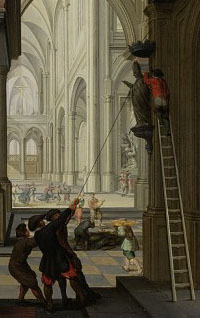  During
the English Civil War, Bishop Joseph Hall of Norwich described
the events of 1643 when troops and citizens, encouraged by a
Parliamentary ordinance against superstition and idolatry, behaved
thus: During
the English Civil War, Bishop Joseph Hall of Norwich described
the events of 1643 when troops and citizens, encouraged by a
Parliamentary ordinance against superstition and idolatry, behaved
thus:
Lord what work was here! What clattering of glasses! What
beating down of walls! What tearing up of monuments! What
pulling down of seats! What wresting out of irons and brass
from the windows! What defacing of arms! What demolishing
of curious stonework! What tooting and piping upon organ pipes!
And what a hideous triumph in the market-place before all
the country, when all the mangled organ pipes, vestments,
both copes and surplices, together with the leaden cross which
had newly been sawn down from the Green-yard pulpit and the
service-books and singing books that could be carried to the
fire in the public marketplace were heaped together.'
Protestants destroyed Catholic trappings in exactly the same
way early Christians had destroyed pagan trappings, and for
exactly the same reason - according the the Bible they were
idolatrous. In England, William Dowsing was commissioned by
the government to tour of East Anglia to destroy images in churches.
His detailed record of his work in Suffolk and Cambridgeshire
survives:
We broke down about a hundred superstitious Pictures; and
seven Fryars hugging a Nunn; and the Picture of God and Christ;
and divers others very superstitious; and 200 had been broke
down before I came. We took away 2 popish Inscriptions with
Ora pro nobis and we beat down a great stoneing Cross on the
top of the Church.
Just as Christians have suffered more persecution at the hands
of Christians than at the hands of any other group, so Christian
churches and icons have suffered more iconoclasm at the hands
of Christians than at the hands of any other group.
…it is putting a very high value on one's conjectures
to roast a man alive on the strength of them.
Montaigne (1533-1592), Essay "Of Cripples"
Once Europe was won, European Christians began to spread the
word more widely. Europeans had rediscovered the Canary Isles,
known to the ancients, in 1336. The native people, called Guanches,
become subject to a Christian monarch. They originally numbered
between 80,000 and 100,000, but within 200 years they had been
wiped out13.
This style of cultural interaction between Christian Europe
and lands to the west and south was to become a regular pattern.
Christopher Columbus was a devout Christian. In his Book
of Prophecies he made it clear that he felt himself to
have been chosen by God. In later life he sometimes wore the
habit of a Franciscan. His vocation was partly to find gold
to finance a new crusade against the Muslims and partly to bring
Christianity to the benighted heathen. The winning of new souls
for God was a principal objective of his westward voyages. Wherever
he went he made a point of leaving a cross standing as a mark
of Christian domination. The pattern in the Canaries was soon
being imitated on other islands. On Hispaniola, Columbus's men
were instructed to reduce the country to the service of the
Roman Catholic Sovereigns Ferdinand and Isabella. The native
Tainos soon discovered the ramifications of this. Christians
kidnapped Taino boys for slaves and Taino women for concubines.
They hunted Taino men with dogs, for sport, then killed them.
Public burnings at the stake were introduced. So were clippings
of noses and ears, and the lopping off of limbs. A form of slavery
was introduced under the euphemistic name of encomienda.
If a recalcitrant Taino killed a Christian, 100 Tainos would
be killed in retribution. Sometimes the Tainos would be hanged
from gallows then fires lit underneath them. They were roasted
alive in groups of thirteen "in honour and reverence for
our Redeemer and the 12 apostles"14.
The new Christian masters picked up infants, held them by their
feet, and smashed their brains out against rocks.
  By
the time Columbus returned to Spain in 1496 he had not managed
to convert a single Taino. Partly through wanton murder and
partly through infectious diseases brought from Europe, the
population of Hispaniola fell rapidly. In 1492, when Columbus
planted his first cross, the Taino population of Hispaniola
had probably been somewhere between 3 and 8 million. By the
mid-sixteenth century the Tainos were extinct15.
Disease could have decimated the population but could not have
extirpated it. Genocide such as this was the work of man and
his Christian God, not of nature. Christians developed fictions
to justify their behaviour. A popular one was that their victims
were so bestial that it was doubtful whether they were human
at all. Sub-humans did not have souls, so it could not matter
what was done to them. Such sub-humans might look fully human,
but their true natures were given away by activities such as
cannibalism and sodomy. Almost every society that Christians
encountered was sooner or later accused of these practices and
thus dehumanised (as were heretical sects within Christendom).
There is no real evidence — linguistic, historical, archaeological
or anthropological — that cannibalism was any more widespread
in the Caribbean or the Americas, or among heretics, than it
was among orthodox Christians16. By
the time Columbus returned to Spain in 1496 he had not managed
to convert a single Taino. Partly through wanton murder and
partly through infectious diseases brought from Europe, the
population of Hispaniola fell rapidly. In 1492, when Columbus
planted his first cross, the Taino population of Hispaniola
had probably been somewhere between 3 and 8 million. By the
mid-sixteenth century the Tainos were extinct15.
Disease could have decimated the population but could not have
extirpated it. Genocide such as this was the work of man and
his Christian God, not of nature. Christians developed fictions
to justify their behaviour. A popular one was that their victims
were so bestial that it was doubtful whether they were human
at all. Sub-humans did not have souls, so it could not matter
what was done to them. Such sub-humans might look fully human,
but their true natures were given away by activities such as
cannibalism and sodomy. Almost every society that Christians
encountered was sooner or later accused of these practices and
thus dehumanised (as were heretical sects within Christendom).
There is no real evidence — linguistic, historical, archaeological
or anthropological — that cannibalism was any more widespread
in the Caribbean or the Americas, or among heretics, than it
was among orthodox Christians16.
|
Spanish Christians enjoying the spectacle
of non-Christian South Americans being torn to pieces
by dogs.
|
|
|
Cortés, the leader of the Conquistadores was
another keen Christian. He carried around with him an image
of the Virgin Mary. The primary aim of his expedition to the
Americas was "to serve God and spread the Christian faith".
His record was even worse than that of Columbus. Here is an
extract from a proclamation read out by the Conquistadores to
their new subjects:
The Lord God has delegated to Peter and his successors all
power over all people of the earth, so that all people must
obey the successors of Peter (i.e. the Pope). Now one of these
popes has made a gift of the newly discovered islands and
countries and everything that they contain to the kings of
Spain, so that, by virtue of this gift, their Majesties are
now kings and lords of these islands and of the continent.
You are therefore required to recognise Holy Church as mistress
and ruler of the whole world and to pay homage to the King
of Spain as your new lord. Otherwise, we shall, with God's
help, proceed against you with violence and force you under
the yoke of the Church and the king, treating you as rebellious
vassals deserve to be treated. We shall take your property
away from you and make slaves of your women and children.
At the same time, we solemnly declare that only you will be
to blame for the bloodshed and the disaster that will overtake
you17.
They apparently genuinely believed that they were colonising
on behalf of God. The country now known as El Salvador was originally
baptized by Spanish conquistadors as “Provincia De Nuestro
Señor Jesucristo El Salvador Del Mundo” (“
Province Of Our Lord Jesus Christ, The Savior Of The World”).
When Christian Europeans first arrived in the Americas they
had been greatly impressed by the indigenous peoples" simplicity
and friendliness, as well as their way of life. They thought
they had literally found Paradise — the Garden of Eden
described in the book of Genesis. The Spanish were so impressed
by Aztec medicine that the King's physician was sent to study
it, and he spent seven years doing so. We do not know how much
he learned because only a part of his record has survived. Some
idea of the sophistication of the Aztec's medical knowledge
may be adduced from the fact that they knew of some 1,200 medicinal
plants. Much of their knowledge was lost or destroyed. Their
treasures were stolen, buildings razed, and historical evidence
burned. Valuable information about Mayan and Aztec culture was
lost forever. Religious, legal and cultural records were sought
out, seized and burned by men like Archbishop Zumárraga
in Mexico and Bishop Landa in the Yucatan. Zumárraga,
the first Bishop of Mexico, did his best to obliterate all trace
of pre-Christian religions — including countless manuscripts.
In 1531 he claimed personally to have destroyed over 500 temples
and 20,000 icons. If people hid their icons they were tortured
in order to force them to divulge where they were hidden. Conversions
were effected by beating and imprisonment, or by kidnapping
children to be indoctrinated into the faith.
|
The Compulsory conversion of native Americans
to Christianity by Spanish Jesuit missionaries, c1500
|
|
|
The established pattern was repeated in one location after
another. Accusations of cannibalism and sodomy arose to excuse
Christian atrocities. Inquisitor-Governors like Don Nuño
Guzmán taught that the indigenous population did not
have human souls, and so were subhuman, and incapable of understanding
Christian doctrine. This meant that it was not wrong to rape,
torture, enslave or kill them. Living men could be dismembered
for fun, and their limbs fed to dogs. Babies could be seized
and have their heads dashed against rocks. This was no more
a sin than killing an animal — ie not sinful at all. Not
all authorities agreed with this view. One Dominican in particular,
Bartolomé de Las Casas, championed the rights of the
native peoples, but he was almost a lone voice. In any case
his objections to killing babies could be easily accommodated.
Priests baptised native infants before their brains were dashed
out. Now, if the babies did have souls they were assured of
immediate admission into Heaven. If they didn"t have souls,
then it didn"t matter anyway You can read an English
translation of the full text of De Las Cases's exposé
here.
  As
in Europe the holy sites of the locals were destroyed, or in
some cases taken over as Christian holy sites. The Iglesia
de Nuestra Señora de los Remedios (Church of Our
Lady of Remedies) is a 16th century Mexican Catholic parish
church built on top of the pyramid of Quetzalcoatl in Cholula
in the central Mexican state of Puebla, the largest pyramid
of the ancient world. A pyramid shrine to the Aztec god Huitzilopochtli
was destroyed by Franciscan monks under Pedro del Monte. They
used the stones and the foundation of the shrine to build a
Christian house for themselves, later a Franciscan monastery,
now the Mexican Museo Nacional de las Intervenciones. As
in Europe the holy sites of the locals were destroyed, or in
some cases taken over as Christian holy sites. The Iglesia
de Nuestra Señora de los Remedios (Church of Our
Lady of Remedies) is a 16th century Mexican Catholic parish
church built on top of the pyramid of Quetzalcoatl in Cholula
in the central Mexican state of Puebla, the largest pyramid
of the ancient world. A pyramid shrine to the Aztec god Huitzilopochtli
was destroyed by Franciscan monks under Pedro del Monte. They
used the stones and the foundation of the shrine to build a
Christian house for themselves, later a Franciscan monastery,
now the Mexican Museo Nacional de las Intervenciones.
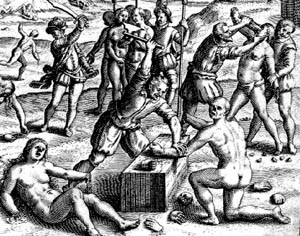  The
Conquistadores killed millions of the indigenous inhabitants
of what are now Mexico and the Yucatan. Before the conquest
the population is believed to have numbered some 25 million;
immediately after it fewer than seven million. By 1650 only
about one and a half million pure-blooded natives remained18.
The pattern in Peru was much the same: Christianity almost destroyed
the Inca civilisation. Knowledge of their written language,
like that of the Mayans and the Aztecs, was somehow "lost",
although it had been well enough known when the Spanish arrived.
Our knowledge of their culture is fragmentary. Following traditional
Christian techniques, temples were pulled down to be replaced
by cathedrals. Whole cities were destroyed, and new Christian
ones constructed. For example modern Mexico City stands on the
site of the Aztec city of Tenochtitlán and its cathedral
on the site of one of the greatest Aztec temples. Some remote
cities that survived for a time were concealed under encroaching
jungle and have only recently been rediscovered. We know the
Incas were great artists because some of their art has survived.
As luck would have it they depicted medical topics on their
pottery. This is how we know of their spectacular accomplishments
in surgery. We know of their interest in public health through
the ruins of their bathing establishments and drainage systems. The
Conquistadores killed millions of the indigenous inhabitants
of what are now Mexico and the Yucatan. Before the conquest
the population is believed to have numbered some 25 million;
immediately after it fewer than seven million. By 1650 only
about one and a half million pure-blooded natives remained18.
The pattern in Peru was much the same: Christianity almost destroyed
the Inca civilisation. Knowledge of their written language,
like that of the Mayans and the Aztecs, was somehow "lost",
although it had been well enough known when the Spanish arrived.
Our knowledge of their culture is fragmentary. Following traditional
Christian techniques, temples were pulled down to be replaced
by cathedrals. Whole cities were destroyed, and new Christian
ones constructed. For example modern Mexico City stands on the
site of the Aztec city of Tenochtitlán and its cathedral
on the site of one of the greatest Aztec temples. Some remote
cities that survived for a time were concealed under encroaching
jungle and have only recently been rediscovered. We know the
Incas were great artists because some of their art has survived.
As luck would have it they depicted medical topics on their
pottery. This is how we know of their spectacular accomplishments
in surgery. We know of their interest in public health through
the ruins of their bathing establishments and drainage systems.
|
Columbus was a Catholic hero, his cruel
excesses lauded by his Church.
His tomb stands in Seville’s cathedral. A catafalue
is held aloft by four allegorical crowned figures in Catholic
priestly vestments, representing the four Catholic kingdoms
of Spain during Columbus’ life, Aragon (front left
bearer), Castille (front right), Navarre (rear left),
and Leon (rear right - hidden).
|
 |
When Roman Catholics from Portugal arrived in the Americas,
their record was much the same as that of the Spanish Catholics,
except that they did not trouble to find a euphemism for slavery.
Since the Portuguese arrived in the sixteenth century, the native
population of what is now called Brazil has fallen by over 95
per cent from an estimated 5,000,000 to around 220,000 by the
late twentieth century. The indigenous peoples of South American
probably owe their survival to the size of their continent.
If it had been smaller, with no remote areas to flee to, their
fate might have been the same as their extinct island cousins.
  In
North America the picture was similar. The Native American population
was reduced from 14,000,000 to around 4,000,000 between 1492
and 160019.
In God's own country the only good Indian was a dead one, and
the only good Indian nation was one that had been exterminated.
Nations and tribes were systematically erased. As churchmen
noted, the dramatic reduction in one population after another
must have been arranged by God to make way for Christian colonisation.
God was killing, or helping kill, millions of Native Americans
in order to help the Christian colonisers. The modern explanation
is that European diseases were to blame. But this is difficult
to square with the facts. No doubt European diseases to which
the Native Americans had no natural immunity played a part but,
as in Hispaniola, disease can account for only part of the death
toll. Another curiosity is that non-Christian Europeans, notably
Scandinavians, had been visiting North America for centuries
without their gods perceiving the need to exterminate native
populations — indeed apparently without causing any harm
at all. The genocide brought by the new arrivals was, as they
said themselves, related to Christianity. Perhaps the Churches
were right. Perhaps God really did help in the genocide. In
North America the picture was similar. The Native American population
was reduced from 14,000,000 to around 4,000,000 between 1492
and 160019.
In God's own country the only good Indian was a dead one, and
the only good Indian nation was one that had been exterminated.
Nations and tribes were systematically erased. As churchmen
noted, the dramatic reduction in one population after another
must have been arranged by God to make way for Christian colonisation.
God was killing, or helping kill, millions of Native Americans
in order to help the Christian colonisers. The modern explanation
is that European diseases were to blame. But this is difficult
to square with the facts. No doubt European diseases to which
the Native Americans had no natural immunity played a part but,
as in Hispaniola, disease can account for only part of the death
toll. Another curiosity is that non-Christian Europeans, notably
Scandinavians, had been visiting North America for centuries
without their gods perceiving the need to exterminate native
populations — indeed apparently without causing any harm
at all. The genocide brought by the new arrivals was, as they
said themselves, related to Christianity. Perhaps the Churches
were right. Perhaps God really did help in the genocide.
|
The sentiment below has been expressed
by leaders of several peoples persecuted by Christians
(Bartolomé de Las Casas for example also recorded
much the same sentiment following a conversation with
a South American survivor, who reasoned that his Christian
persecutors would all be in heaven and everyone he knew
and respected would be in hell)
|
|
|
In North America, hunting Indians with dogs was known as the
Spaniard's method. It was advocated by Cotton Mather and other
clergymen. Reverend Solomon Stoddard, one of New England's most
esteemed religious leaders, formally proposed in 1703 to the
Massachusetts Governor that the colonists be given the financial
wherewithal to purchase and train large packs of dogs 'to hunt
Indians as they do bears', the reasoning being that dogs would
catch many an Indian who would be too light of foot for the
townsmen. This was not considered inhuman, for the Indians,
in Stoddard's view, "act like wolves and are to be dealt
with as wolves." Three years later Massachusetts passed
an act for the raising of dogs to better secure the frontier
borders20.
The "Discovery Doctrine"
The "Discovery Doctrine" is a legal principal of
public international law established by Christian countries
to establish that Christian countries have a right to dispossess
non-Christian peoples. The doctrine can be traced to Pope Nicholas
V's papal bull Romanus pontifex of 1455 which allowed
Portugal to claim lands in West Africa. Pope Alexander VI's
bull Inter caetera of 1493 had extended to Spain the
right to conquer newly found lands, retrospectively justifying
Columbus's conquests. The Treaty of Tordesillas had then
clarified that only non-Christian lands could thus be taken,
as well as drawing a line of demarcation to allocate potential
discoveries between Spain and Portugal. Non Catholic Christians
also adopted the principal. Exploration charters given to John
Cabot show that the British had operated under the Discovery
Doctrine, and the same doctrine carried over into the law of
the United States of America.
|
Floyd Westerman is here referring to
the Discover Doctrine
|
|
|
The Discovery doctrine was expounded by the Supreme Court of
the United States in a series of decisions, most notably Johnson
v. M'Intosh in 1823. Chief Justice John Marshall justified the
way in which colonial powers laid claim to lands belonging to
sovereign indigenous nations during the Age of Discovery. Under
the Discovery Principal, title to lands lay with the government
whose subjects explored and occupied a territory whose inhabitants
were not subjects of a European Christian monarch. The doctrine
has been used extensively to support decisions invalidating
or ignoring aboriginal possession of land in favour of colonial
or post-colonial Christian governments. Chief Justice Marshall
explained the Court's reasoning, explaining that the doctrine
as justified by the inferior character of native non-Christian
cultures.
|
The Treaty of Tordesillas was signed
at Tordesillas (now in Valladolid province, Spain) on
7 June 1494. It divided the newly discovered lands outside
Europe between the Christian powers Portugal and Spain
along a meridian 370 leagueswest of the Cape Verde islands
(off the west coast of Africa). The lands to the east
would belong to Portugal and the lands to the west to
Spain. The treaty was ratified by the Crowns of Castile
and Aragon on 2 July 1494 and by Portugal on 5 September
1494. The other side of the world would be divided a few
decades later by the Treaty of Zaragoza or Saragossa,
signed on 22 April 1529, which specified the antimeridian
to the line of demarcation specified in the Treaty of
Tordesillas. Originals of both treaties are kept at the
Archivo General de Indias in Spain and at the Arquivo
Nacional da Torre do Tombo in Portugal.
|
|
|
A related doctrine was that of Terra nullius denoting
"land belonging to no one". Terra nullius,
such as an uninhabited island, could be claimed by the power
that first discovered it. The principal was applied not only
to uninhabited lands, but to any "barbarian" ie non-Christian
lands. It has been applied to many countries, most notably Australia.
The first legal test of terra nullius in Australia occurred
with the decision of R v Tommy (Monitor, 28 November 1827),
reinforced by the decisions of R v Boatman or Jackass and Bulleyes
(Sydney Gazette, 25 February 1832) and R v Ballard (Sydney Gazette,
23 April 1829). In 1835 Governor Bourke implemented the doctrine
of terra nullius in proclaiming that Indigenous Australians
could not sell or assign land, nor could an individual person
or group acquire it, other than through distribution by the
Crown. The New South Wales Supreme Court made explicit use of
the term terra nullius in R v Murrell and Bummaree (unreported,
New South Wales Supreme Court, 11 April 1836, Burton J). The
principal of Terra nullius was endorsed by the Judicial
Committee of the Privy Council in Cooper v Stuart in 1889.
|
A modern take on the principal of Terra
nullius
|
|
|
Christian Vandalism in the East
The story was much the same in the East. Christian missionaries
believed themselves to be inspired by God. This gave them justification
for conquering lands, vandalising possessions, burning down
houses, kidnapping children, and forcibly converting everyone
they came across - Moslems, Hindus, Buddhists, animists, even
Christians belonging to ancient Christian sects, as in Goa.
As in early times, new converts were encouraged to terrorise
their neighbours and even their own families. Here are a few
quotations from the Jesuit Saint Francis Xavier, documented
from his letters by a fellow Jesuit:
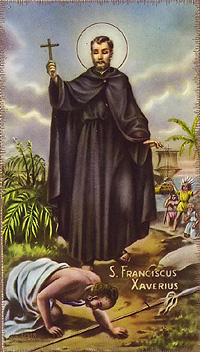  When
I have finished baptizing the people, I order them to destroy
the huts in which they keep their idols; and I have them break
the statues of their idols into tiny pieces, since they are
now Christians. When
I have finished baptizing the people, I order them to destroy
the huts in which they keep their idols; and I have them break
the statues of their idols into tiny pieces, since they are
now Christians.
(Costelloe, M. Joseph, S.J. The Letters and Instructions
of Francis Xavier. St. Louis: Institute of Jesuit Sources,
1992 pp 117-8)
When a sinner refused to listen to his words, and was deaf
to arguments and appeals drawn from the terrors of hell or
the sacred memories of the Passion of Christ, Xavier seized
his scourge and beat his bared shoulders until the blood ran,
to soften that hardened heart.
Costelloe, M. Joseph, S.J. Saint Francis Xavier, Apostle
of India and Japan, The America Press, New York, 1919,
P38
When all are baptized I order all the temples of their false
gods to be destroyed and all the idols to be broken in pieces.
Letter From Francis Xavier in Cochin to the Society of Jesus
at Rome, January 27th, 1545.
Missionaries like Saint Francis believed that non-Christians
worshipped the devil, or at least they purported to believe
it:
It is not too much to say that in that land of darkness and
death Satan ruled as master.
Costelloe, M. Joseph, S.J. Saint Francis Xavier, Apostle
of India and Japan, The America Press, New York, 1919,
P45
It was Saint Francis Xavier who requested the establishment
of the Goan
Inquisition , which burned people alive for the crime of
failing to agree with the Church on every point of official
doctrine. It is also apparent to rationalists that missionaries
continued to use the early Christian practice of assassinating
those who preferred to keep their old religion. As in early
Christian accounts of the miraculous and mysterious deaths of
their enemies, it seems clear that those deaths were neither
miraculous nor mysterious, but cases of murder, certainly the
local Hindus still relate stories of torture and murder, passed
down the generations orally. Here is the traditional Christian
way of saying the same thing:
In some mysterious way God inflicted the most signal punishment
on those who opposed His Saint, and their punishment became
a warning and a household tale throughout the East.
Costelloe, M. Joseph, S.J. Saint Francis Xavier, Apostle
of India and Japan, The America Press, New York, 1919,
P56
Wherever Christians discovered countries that were climatically
and economically desirable, the inhabitants were either expelled
or exterminated. This happened under Roman Catholics and Protestants
alike irrespective of the settlers" country. British Protestants
did it in North America, Australia and New Zealand. Dutch Protestants
did it in the Far East. French Catholics did it in Canada, while
Spanish and Portuguese Catholics did it throughout South America
and elsewhere around the world. We might know a great deal more
about the history of mankind if the Christian Churches had not
gone so far out of their way to destroy the vestiges of their
victims" tradition and culture. The purpose and history
of the great stone heads on Easter Island was apparently well
known when missionaries first arrived there, but the missionaries
were more intent on destroying information than on preserving
it. So it is that the details were lost. Sacred objects throughout
Africa, South America and New Guinea have been seized and destroyed,
and this is still happening today. Any small remote tribes lucky
enough to have avoided contact with Europeans are sought out
to be told the Good News. The inevitable result, which the missionaries
must know, is that their traditional ways will be undermined.
Some will die of diseases like measles, influenza, typhus, pneumonia,
tuberculosis, diphtheria and pleurisy, to which they have no
natural immunity. Most of the remainder will find themselves
without a stable way of life, deprived of their religion, their
culture, their way of life, even their traditional clothing.
Emotional turmoil takes its toll as well. Suicide was rare or
even unknown in many communities before Christianity arrived.
It was for example unknown to the Guarani-Kaiowa in Brazil until
the 1980s. Then Protestant missionaries arrived to save them
for Jesus. By 1991 their suicide rate was 4.5 per 1,000 —
almost 150 times Brazil's national average.
|
"Let's go save the heathens"
- a concept still taught in Christian schools
|
|
|
Hinduism was too widespread in India for Christianity to make
much of an impact, but they still tried to destroy it and its
associated culture, especially in Goa where the Inquisition
operated. Christians of all principle denominations were still
trying to obliterate Hindu culture into the twentieth century.
For them Hindu gods were demons, and everything to do with them
was intrinsically evil. Mahatma Gandhi's autobiography, The
Story of My Experiments with Truth, records the final stages
were Christians in India were restricted to hurling abuse and
exercising social pressure. Speaking of Christianity he wrote:
I developed a sort of dislike for it. And for a reason.
In those days Christian missionaries used to stand in a corner
near the high school and hold forth, pouring abuse on Hindus
and their gods. I could not endure this. I must have stood
there to hear them once only, but that was enough to dissuade
me from repeating the experiment. About the same time, I heard
of a well known Hindu having been converted to Christianity.
It was the talk of the town that, when he was baptized, he
had to eat beef and drink liquor, that he also had to change
his clothes, and that thenceforth he began to go about in
European costume including a hat. These things got on my nerves.
Surely, thought I, a religion that compelled one to eat beef,
drink liquor, and change one's own clothes did not deserve
the name. I also heard that the new convert had already begun
abusing the religion of his ancestors, their customs and their
country. All these things created in me a dislike for Christianity.
As the tentacles of Christianity have spread overseas it has
become expert at destroying other cultures. Undeveloped countries
find missionary activity increasingly unacceptable. At the time
of writing over 75 countries have excluded Christian missionaries
as undesirable, and the number is steadily increasing at around
3 per year. Not to be thwarted, missionaries run undercover
illegal operations, referring to themselves as tentmakers after
St Paul, who did the same thing (Acts 18:1-4). The story is
the same from the Americas to Africa, Indo-China, and Australasia.
All around the world the sad refuse of humanity can be found
bobbing in the wake of well-meaning Christian missionaries.
Illustrations of Christian Vandalism
| |
| |
| |
|
|
| |
| |
|
|
| |
| |
|
|
| |
| |
|
|
| |
|
Aphrodite mosaic Zeugma, Turkey Archaeological
Museum of Gaziantep
Vast amounts of classical art was valdalised by Christians
(and later by Muslims), especially faces
This fact is rarely mentioned by museums in their tourist
literature.
|
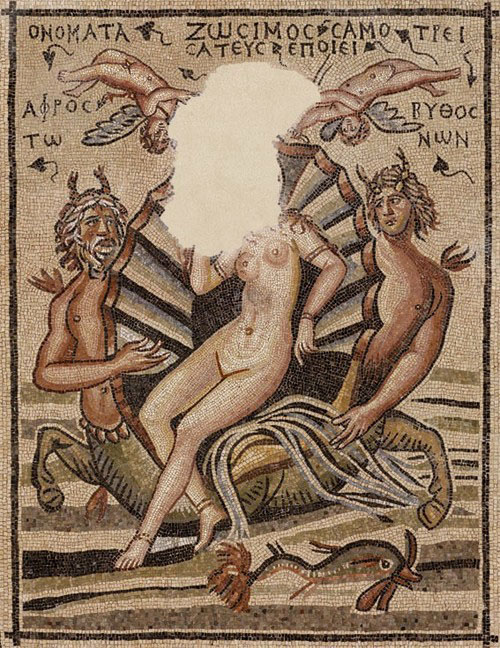 |
| |
|
the-glee-of-smashing-idols-calvinists-in-a-catholic-church
|
|
|
| |
| |
|
Paulus in Ephesus - Dore. Acts19.19
|
|
|
| |
| |
| |
| |
| Foxe Zinca |
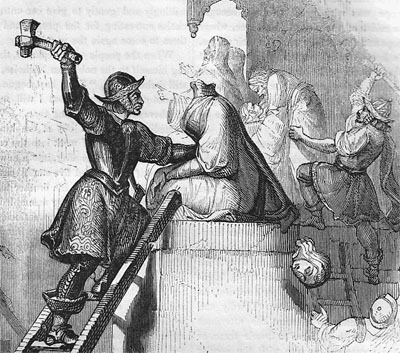 |
| |
| |
| |
|
Foxe Huss Books
|
|
|
| |
| |
| |
|
Pokrštenje Hrvata Bela Cikoš
Sesija
|
|
|
|
Pokrštenje Hrvata Bela Cikoš
Sesija
|
|
|
| |
| |
| |
| |
| |
| |
| |
| |
| |
| |
| |
| |
| |
| |
| |
| |
| |
| |
| |
| |
| |
| |
| |
| |
| |
|
|
|
|
|
|
|
|
|
|
|
|
|
|
|
|
|
|
|
|
|
|
|
|
|
|
|
|
|
|
|
|
|
|
|
|
|
|
Buy the Book from Amazon.com
|
|
|
|
|
|
Buy the Book from Amazon.co.uk
|
|
|
| |
| |
| More Books |
|
|
|